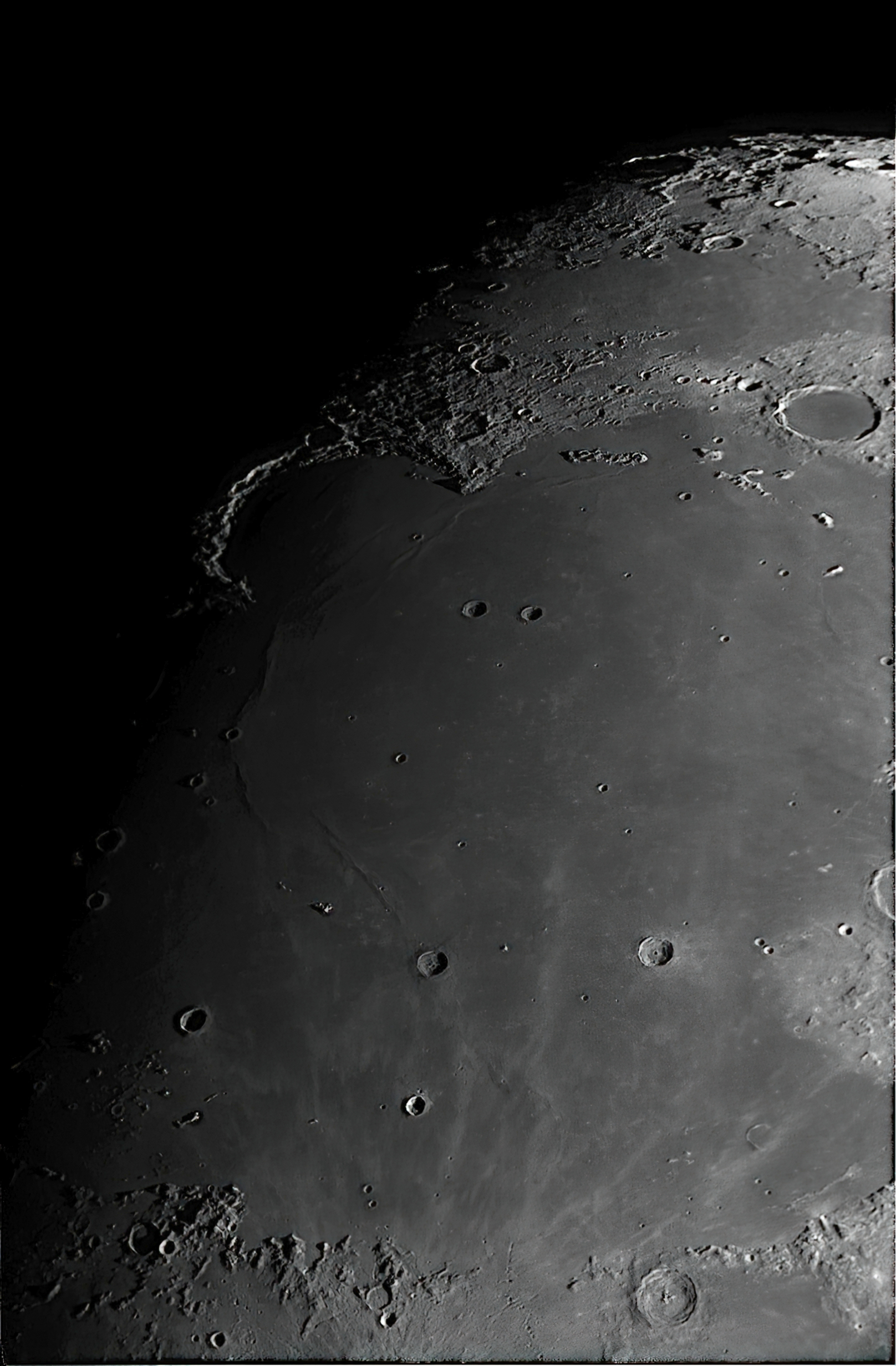Approaching the Longest Days
07 June 2022

Mare Imbrium, the lunar "Sea of Rains", imaged 2021 May 22 from Alexandria, Virginia
with an Explore Scientific AR102 10.2-cm (4-inch) f/6.5 refractor, TeleVue 2x "Big Barlow" lens, and a ZWO ASI224MC CCD imager.
The large semi-circular formation at upper right is Sinus Iridum, the "Bay of Rainbows". The dark-floored crater at upper right is Plato.
The Moon dives through the springtime constellations toward the southern reaches of the ecliptic this week. She begins the week at her First Quarter phase and waxes to Full Moon, which will occur on the 14th at 7:52 am Eastern Daylight Time. June’s Full Moon has many popular names, among which are the Strawberry Moon, Rose Moon, Mead Moon, and Honey Moon. These traditional names not only refer to seasonal delights that may be collected in June, but also to the warm tone of Luna’s fully illuminated disc. From northern latitudes the Moon appears very low over the southern horizon, so her light must shine through denser layers of Earth’s atmosphere. Since the molecules in our air preferentially scatter blue light the Moon appears less blue in her hue, which means that she is somewhat more red or amber in color.
By the end of the week we enter the two-week period of events surrounding the summer solstice. The year’s earliest sunrise occurs on the 14th, when Old Sol crests the horizon at 5:10 am EDT here in Washington. By the time of the solstice itself, which occurs on the 21st, the Sun begins rising later in the morning, but the time of latest sunset won’t occur until the 28th, so the longest day still falls on the date of the solstice itself. The discrepancies between latest sunset and earliest sunrise occur due to our need for precise time versus the apparent time kept by the rotating Earth. If we still kept track of time using sundials, all of these phenomena would coincide on the solstice itself. However, our modern lives are driven by technology, with seconds defined by resonances in atomic frequency standards rather than shadows cast by sticks.
The Moon continues to dominate the evening sky this week, so if you are looking for something in the sky to explore she is an obvious choice. This week the sunrise terminator creeps across the largest of Luna’s dark so-called “seas” that mark the remains of colossal impacts that occurred early in the solar system’s formation. The largest of these great circular basins, Mare Imbrium, the Sea of Rains, is a vast feature some 1250 kilometers (750 miles) in diameter that requires several days to reveal its full extent as the terminator slowly moves from night to night. It dominates the northern reaches of Luna’s disc, while a more chaotic, crater-packed region dominates the south. These cratered regions have been subjected to 4.5 billion years of bombardment, while the smoother floor of Mare Imbrium was formed about 3.8 billion years in the past. The contrast between these landscapes bears mute testament to the violence of the early stages of the forces that built our planet and its satellite.
The brightening Moon washes out the fainter stars of the late spring sky, but there are a few bright stars that can be easily glimpsed through the Moon’s glare and hazy skies. High in the south at around 10:00 pm you will find the bright star Arcturus, brightest star in the northern hemisphere of the sky whose rosy tint contrasts nicely with the blue hue of Spica, which lies about midway between Arcturus and the southern horizon. As the night passes look to the southeast for the ruddy star Antares, the “heart” of Scorpius, the Scorpion. Superficially it resembles Arcturus in color, but it is over 100 times more distant. It is a red supergiant star that is nearing the end of its cosmic life, much like Betelgeuse in Orion. Late-night skywatchers can watch the stars of the Summer Triangle rising in the east.
Early morning skywatchers can see all five of the planets visible to the naked eye in the gathering morning twilight. Saturn will be close to the meridian in the south, with bright Jupiter higher up in the southeast. As the week begins ruddy Mars lies just five degrees east of Old Jove, but he doubles that distance by week’s end. Dazzling Venus rises at around 4:00 am, and by the end of the week she is joined by Mercury, which will rise around 40 minutes later. Mercury should be easier to spot over the next few weeks, and all five planets should put on a good show through the month’s end.